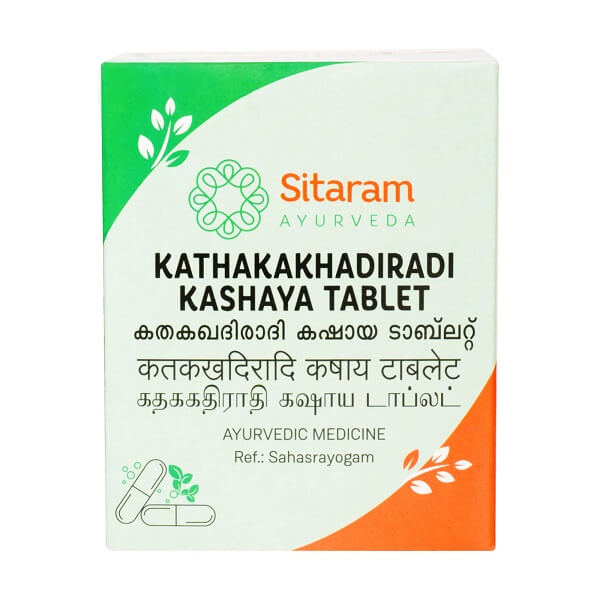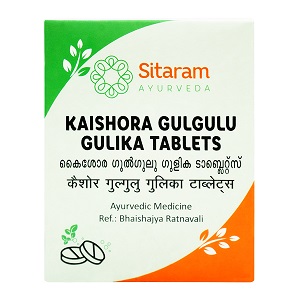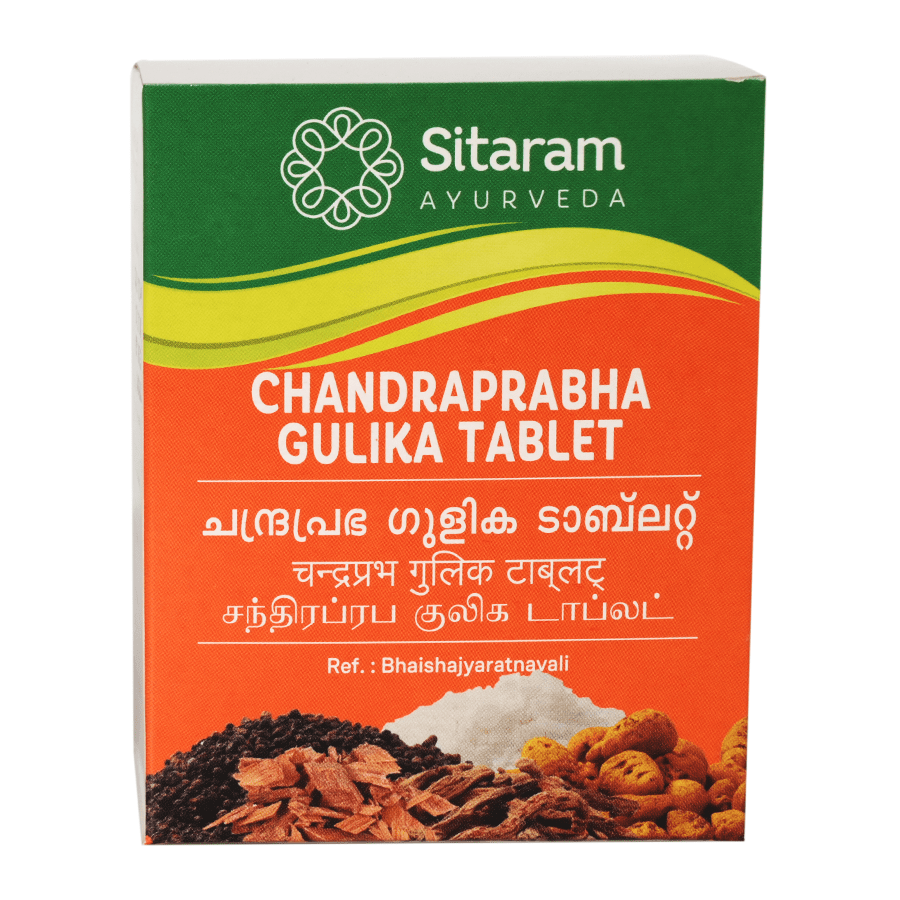Description
The management of high blood sugar entails improved circulation, oxygenation and cleansing of the circulatory body fluids. Katakakhadiradi Kashayam tablet is a combination of herbal drugs that is beneficial in maintaining healthy blood sugar levels in the body.
Excessive sugar levels in the circulating blood are detrimental to all the vital organs. It leads to widespread inflammation and increased oxidative stress in the body. ‘Prameha’ is the Ayurvedic disease pathology that brings about hyperglycemia and associated signs and symptoms like excess thirst, hunger and perspiration.
Features and benefits of Katakakhadiradi Kashayam tablet –
- Katakakhadiradi Kashayam tablet is an excellent remedy for high levels of circulating blood sugar. All the signs and symptoms associated with hyperglycemia like excessive thirst, hunger, perspiration and fatigue are effectively managed by this herbal decoction.
- It lowers insulin resistance in the body. Katakakhadiradi Kashayam tablet also helps kick into action a sluggish basal metabolic rate.
- It protects the body against diabetic complications like neuropathy, nephropathy and retinopathy. Arrests progress of already manifest signs and symptoms.
- Kathakakhadiradi Kashayam purifies blood and stimulates circulation. It is used in the management of diabetic carbuncles.
- Pacification of ‘Pitta’ is the hallmark of this combination of cooling and astringent ingredients. It prevents inflammation and oxidative stress in the body.
- Katakakhadiradi Kashayam tablet is also known to detoxify and rejuvenate the body fatigued by hyperglycemia.
Key ingredients:
KATAKA (Strychnos potatorum)
According to Ayurveda seeds cures strangury, urinary discharges, head diseases, etc., Roots cure leukeoderma where as fruits are useful in eye diseases, thirst, poisoning, and hallucinations. The fruits are emetic, diaphoretic, alexiteric, etc., The seeds are bitter, astringent to bowels, aphrodisiac, tonic, diuretic and good for liver, kidney complaints, gonorrhea, colic and diabetes.
KHADIRA (Acacia catechu)
Commonly known as Karingali, it is used for stomach problems such as diarrhea, swelling of the colon (colitis), and indigestion. It is also used orally for pain from osteoarthritis and topically to treat pain, bleeding, and swelling (inflammation). Also found to be effective in complications of diabetes.
AMALAKI (Embilica officinalis)
It is also known as Embilica officinalis. The benefits of Amalaki are numerous, which part of why it is considered to be the best antiaging ingredient in all of Ayurveda. metabolism, elimination and normal liver function and excellent for the hair and skin. The fruit is an important source of Vitamin C, minerals, and amino acids. It contains three times the protein concentration and Vitamin C (ascorbic acid) concentration than apple.
DARUHARIDRA (Berberis aristata)
Also known as Haldi, this vibrant yellow colored spice checks the worsening of Pitta doshas like jaundice. The powerful anti-inflammatory and antiseptic properties of turmeric help in evading infections and treats various skin conditions. Tree Turmeric is a revered herb in Ayurvedic medicine. Possessing antibacterial, anti-inflammatory, antipyretic and antiseptic properties, the herb is used as a cholagogue, stomachic, laxative and diaphoretic.
PATHA (Cyclea peltata)
It is widely used in bone fracture and wound healing. Also used in the treatment of fever and act as a breast milk purifier. Commonly known as Indian moonseed, it enhances immunity and prevents inflammation of the respiratory passages due to its immunomodulatory and anti-inflammatory properties. It is used in conditions including infertility, wound, hypertension, and skin diseases.
HARIDRA (Curcuma longa)
Haridra is also called known as Curcuma longa. The anti-inflammatory and antioxidant properties of Haridra assist in preventing the progression of diabetes related changes in organs like the kidneys, retina, nerve cells and minute blood vessels in the body . Turmeric is a vital herb in Ayurvedic medicine, whose spice form can be recognized by its dazzling, yellow color. The root of the herb, used either fresh or dried, has a host of medicinal benefits. It acts as a carminative and also enhances the complexion and skin-tone. In addition, Turmeric can be used to combat liver damage, respiratory disorders and ulcers.
AMRA (Mangifera indica)
The kernel of mango is astringent and possesses antimicrobial activity. This property is tapped into in this composition.
HAREETHAKI (Terminalia chebula)
Popularly known as Indian walnut for its innumerable benefits or Indian hog plum in English, it is extremely valuable for its role in improving hair health. It is useful for treating scalp infections like dandruff, itching and hair fall. It also strengthens them from the roots, prevents breakage and loss of hair and bestows silky soft smooth hair. Chebulic Myrobalan is one of the three key ingredients in Triphala, a natural compound that provides overall support for digestive function and helps ensure that the digestive tract works at optimal levels. The Ayurvedic Pharmacopoeia of India has documented the use of the powdered herb in intermittent fevers and chronic fevers, anemia and polyuria. Chebulic Myrobalan can also be used to treat gastrointestinal and respiratory disorders.
MUSTA (Cyperus rotundus)
Commonly known as common nut sedge, it is effective in gastritis, irritable bowel syndrome. Due to its breast purification property it is used during post partum care to avoid indigestion to the child. Nut Grass has a long history of medicinal use in the Ayurvedic system of medicine. Its benefits have been documented in the Charaka Samhita, one of Ayurveda’s prime texts. The herb also features heavily in medicinal texts of Chinese Traditional Medicine (CTM). In CTM, Nut Grass is credited with the ability to restore ‘Qi’, the natural patterns in which the body functions.


 Sign In
Sign In Cart
Cart 







D Ramkumar (verified owner) –
good
Dinesh Kamath (verified owner) –
MADHUSUDANAN UNNY (verified owner) –